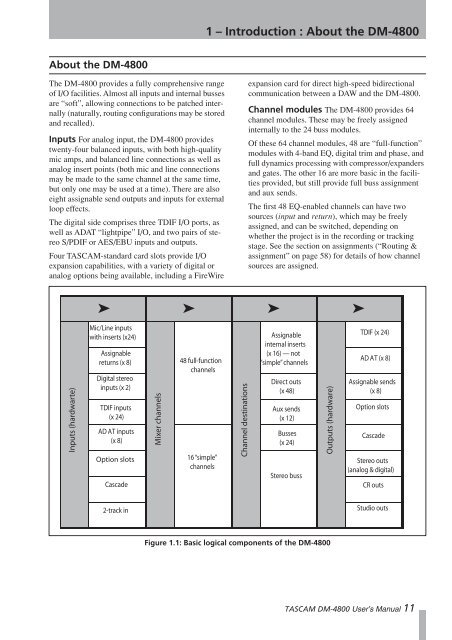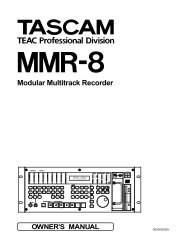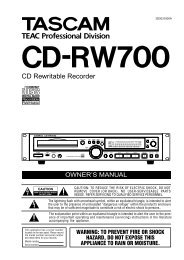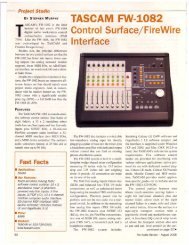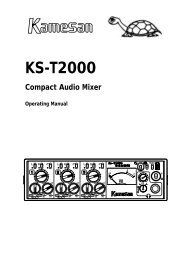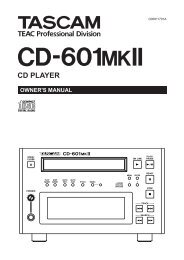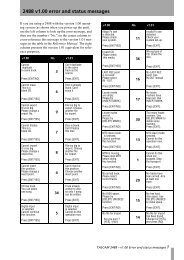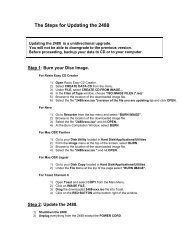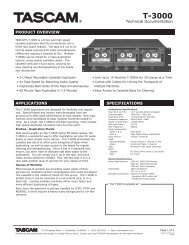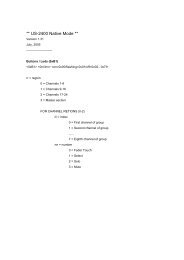DM-4800 OWNER'S MANUAL - zZounds.com - Tascam
DM-4800 OWNER'S MANUAL - zZounds.com - Tascam
DM-4800 OWNER'S MANUAL - zZounds.com - Tascam
Create successful ePaper yourself
Turn your PDF publications into a flip-book with our unique Google optimized e-Paper software.
About the <strong>DM</strong>-<strong>4800</strong><br />
The <strong>DM</strong>-<strong>4800</strong> provides a fully <strong>com</strong>prehensive range<br />
of I/O facilities. Almost all inputs and internal busses<br />
are “soft”, allowing connections to be patched internally<br />
(naturally, routing configurations may be stored<br />
and recalled).<br />
Inputs For analog input, the <strong>DM</strong>-<strong>4800</strong> provides<br />
twenty-four balanced inputs, with both high-quality<br />
mic amps, and balanced line connections as well as<br />
analog insert points (both mic and line connections<br />
may be made to the same channel at the same time,<br />
but only one may be used at a time). There are also<br />
eight assignable send outputs and inputs for external<br />
loop effects.<br />
The digital side <strong>com</strong>prises three TDIF I/O ports, as<br />
well as ADAT “lightpipe” I/O, and two pairs of stereo<br />
S/PDIF or AES/EBU inputs and outputs.<br />
Four TASCAM-standard card slots provide I/O<br />
expansion capabilities, with a variety of digital or<br />
analog options being available, including a FireWire<br />
Inputs (hardwarte)<br />
1 – Introduction : About the <strong>DM</strong>-<strong>4800</strong><br />
Figure 1.1: Basic logical <strong>com</strong>ponents of the <strong>DM</strong>-<strong>4800</strong><br />
expansion card for direct high-speed bidirectional<br />
<strong>com</strong>munication between a DAW and the <strong>DM</strong>-<strong>4800</strong>.<br />
Channel modules The <strong>DM</strong>-<strong>4800</strong> provides 64<br />
channel modules. These may be freely assigned<br />
internally to the 24 buss modules.<br />
Of these 64 channel modules, 48 are “full-function”<br />
modules with 4-band EQ, digital trim and phase, and<br />
full dynamics processing with <strong>com</strong>pressor/expanders<br />
and gates. The other 16 are more basic in the facilities<br />
provided, but still provide full buss assignment<br />
and aux sends.<br />
The first 48 EQ-enabled channels can have two<br />
sources (input and return), which may be freely<br />
assigned, and can be switched, depending on<br />
whether the project is in the recording or tracking<br />
stage. See the section on assignments (“Routing &<br />
assignment” on page 58) for details of how channel<br />
sources are assigned.<br />
➤ ➤ ➤ ➤<br />
Mic/Line inputs<br />
with inserts (x24)<br />
Assignable<br />
returns (x 8)<br />
Digital stereo<br />
inputs (x 2)<br />
TDIF inputs<br />
(x 24)<br />
AD AT inputs<br />
(x 8)<br />
Option slots<br />
Cascade<br />
2-track in<br />
Mixer channels<br />
48 full-function<br />
channels<br />
16 “simple”<br />
channels<br />
Channel destinations<br />
Assignable<br />
internal inserts<br />
(x 16) — not<br />
“simple” channels<br />
Direct outs<br />
(x 48)<br />
Aux sends<br />
(x 12)<br />
Busses<br />
(x 24)<br />
Stereo buss<br />
Outputs (hardware)<br />
TDIF (x 24)<br />
AD AT (x 8)<br />
Assignable sends<br />
(x 8)<br />
Option slots<br />
Cascade<br />
Stereo outs<br />
(analog & digital)<br />
CR outs<br />
Studio outs<br />
TASCAM <strong>DM</strong>-<strong>4800</strong> User’s Manual 11


